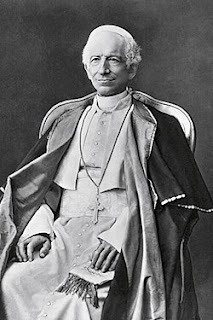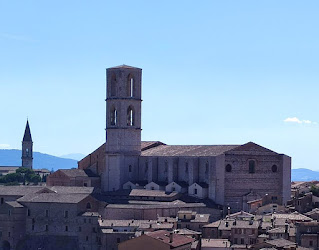Why the papal name Leo has been inspirational
 |
| A photograph of Pope Leo XIII taken at the time of his election |
Leo XIII served as pope for 25 years, despite fears after his election in 1878 that he was in delicate health. Only three popes have served for longer. They were the first pope, Saint Peter the Apostle, Pope Pius IX, and Pope John Paul II.
He was born Gioacchino Vincenzo Raffaele Luigi Pecci in Carpineto Romano in Lazio in 1810. His family were both noble and religious and he was educated at the Jesuit College of Viterbo. He enjoyed Latin and was writing his own poems in Latin by the age of 11.
After his mother died, his father, Count Domenico Pecci, wanted his children to be near him, so he moved to Rome, where he attended the Jesuit Collegium Romanum.
As a young man, Pecci studied at the Pontifical Ecclesiastical Academy, where he won awards for academic excellence. He was appointed as a prelate by Pope Gregory XVI before he was even ordained as a priest and he was later appointed as papal legate to Benevento.
He faced a decaying local economy badly affected by Mafia and Camorra organisations linked to the local aristocracy. Pecci arrested the most powerful aristocrat in Benevento and had others either killed or imprisoned. He reformed the tax system to stimulate trade.
He was then sent to Perugia where his fight against corruption continued. When it was claimed a baker was selling bread below the legal weight, he personally went to the bakery and had all the bread weighed. The bread found to be below the weight was confiscated and distributed to poor people.
 |
| A book illustration showing Pecci as Nuncio to Belgium |
From 1846 to 1877 he was a popular Archbishop of Perugia. He formed homeless shelters for boys, girls, and women, opened a bank, Monte di Pietà, which provided low-interest loans to poor people, and he created soup kitchens.
After being appointed Cardinal Bishop of Crisogno in 1853, Pecci began to address the role of the church in modern society, defining it as ‘the mother of material civilisation’ because it upheld the dignity of working people and their right to a fair wage and to go on strike.
He was appointed to an office in the papal household in 1877 by Pope Pius IX, which required him to move back to Rome. After Pius IX died in 1878, Cardinal Pecci was elected as the new pope on the third ballot and he chose the papal name Leo XIII. He said he had always venerated Pope Leo XII because he admired his conciliatory attitude to foreign governments and his interest in education.
It was thought at the time that the more conservative cardinals voted for Pecci because they believed his age and health meant that his papacy would be brief, and they were trying to thwart other candidates they did not want to see elected.
However, during the next 25 years, Leo XIII worked to improve understanding between the church and the modern industrial world. He tried to reverse the trend towards an increasingly impoverished working class with socialist sympathies and anticlerical views, and he improved relations with Russia, Germany, France, and Britain. He also made the Catholic Church become more open to scientific progress.
 |
| An 1878 magazine illustration of the Pecci house in Carpineto Romano |
He elevated the English Catholic theologian John Henry Newman to be a cardinal, along with creating the first cardinals from Australia, Canada, Slovenia, and Armenia.
After becoming ill in June 1903, Leo XIII died in the Apostolic Palace of pneumonia on July 20.
He was the first pope to have been born in the 19th century and the first to die in the 20th century. He had run the Catholic Church with efficiency and helped to gain more respect for the papacy at home and abroad.
Leo XIII was entombed in Saint Peter’s Basilica briefly, but was later moved to the Basilica of Saint John Lateran in Rome, a church in which he had been particularly interested.
When the American cardinal Robert Francis Prevost was elected as pope in 2025, he said one of the main reasons he chose Leo as his papal name was because of the social justice encyclical Rerum Novarum that had been written by Pope Leo XIII.
 |
| Piazza Regina Margherita has a fountain dedicated to Pope Leo XIII |
Carpineto Romano, where Pope Leo XIII was born, is a small town in Lazio, about 37 miles (60km) southeast of Rome. There are still Roman ruins and medieval buildings to be seen, but it was made more splendid in the 16th century by the wealthy Aldobrandini family. It was a duchy under Donna Olimpia Aldobrandini, who played a significant role in its development. The town centre still has narrow cobblestone streets and some elegant palazzi with limestone doorways bearing Italian and Latin inscriptions. The Church of Saint John was significantly reworked while Leo XIII was Pope. It has a portal with bronze panels by the sculptor Tommaso Ambrosetti, who was from nearby Anagni. There is a fountain commemorating Leo XIII in Piazza Regina Margherita. Carpineto Romano is situated in the Lepini mountains, offering views of the plains of Latina and the Sacco river valley. The town attracts many visitors to the annual Pallio della Carriera festival, which re-enacts the splendour of the Aldobrandini era and includes a historical procession and a horse race, as well as stalls and exhibits highlighting the town's traditional cuisine.
 |
| The Basilica di San Domenico in Perugia has a bell tower that rises to almost 200ft (60m) |
Perugia, the capital of Umbria, where Pope Leo XIII spent more than 30 years as an archbishop, is a vibrant city that combines strong echoes of a significant history with an effervescent modern culture. Standing atop a hill in the Tiber valley, in Etruscan times it was one of the most powerful cities of the period and its strategic position has made it a target for invading armies ever since. The city of today evolved around a fortified medieval village, at the heart of which is Piazza IV Novembre, which has a fountain, the Fontana Maggiore, sculpted by Nicolo and Giovanni Pisano. The city’s imposing Basilica di San Domenico, built in the early 14th century also to designs by Giovanni Pisano, is the largest church in Umbria, with a distinctive 60m (197ft) bell tower and a 17th-century interior, designed by Carlo Maderno. It contains the tomb of Pope Benedict XI, who died in 1304. Nowadays, Perugia is term-time home to some 34,000 students at the University of Perugia and hosts the world-renowned Umbria Jazz Festival each July. Perugia is the home of the Perugina chocolate company, famous for Baci, which it celebrates with a chocolate festival each summer.
Also on this day:
1890: The birth of painter Giorgio Morandi
1937: The death of electrical engineer Guglielmo Marconi
1959: The birth of racing driver Giovanna Amati
.png)








.jpg)





















